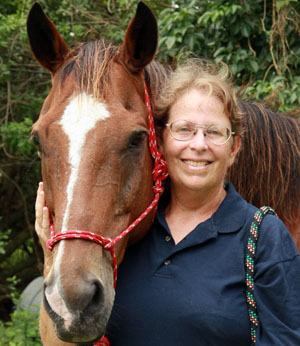TALES FROM THE TRAILS
What if your equine gave birth to a foal and would never let you touch it, and would rather bite and kick you? That’s just the way Terry Wolf, wildlife director at Lion Country Safari, likes it.
In April, the park’s herd of Kulan — one stallion, 14 mares and a few geldings — added eight new foals. Adorable, but untouchable.
“Also called Asiatic wild asses, Kulan have never been domesticated,” Wolf explained. “Even the renowned Mongolian horsemen never managed to tame them. They love to bite and kick.”
Their scientific name is equus hemionus. Wolf explained they’re onagers; not true wild horses, like zebras, but closer to Sicilian donkeys. They’re an endangered species.
In historic times, the Asiatic wild ass ranged through much of Mongolia, north to Russia. It could be found in what today is Kazakhstan, Ukraine, Turkey, Syria, northern Iraq, Afghanistan, Pakistan, eastern India, and as far south as central Saudi Arabia. Their natural habitat is mountain steppe, steppe, semi-desert and desert plains.
By the 19th century, their range had declined significantly. Today, the most abundant population occurs in the southern part of Mongolia in the Gobi Desert.
However, they’re at risk due to illegal hunting for their meat and hides. They’re also losing habitat due to increased human incursion: domestic livestock pastures, roads, railroads and mining. The global population of mature Kulan has declined by 52 percent in the last 16 years. There are only about 8,000 left in the wild.
“We got our first Kulan four years ago,” Wolf said. “Back in the 1960s, a somewhat eccentric man who lived in New Mexico had imported a herd and decided to release a group of them into the mountains. Since they had no natural predators, they thrived. Nothing gets them. They work cooperatively and drive off wolves and coyotes.”
As you can imagine, eventually this became a problem. “So, he offered them for free to anyone who could catch them,” Wolf said. “And that was another problem. This is high desert. There’s nothing to hide behind. They can see anything approaching 20 miles away. Eventually, some were caught, but they’re impossible to work with. Plus, if you put them too close to each other, they really vicious, so you could get only one at a time into a horse trailer. And even if you got one home, what were you going to do with it?”
Even zoos had some difficulty keeping Kulan. They don’t readily mix well with other species, and they need lots of space. However, Wolf had a specific job in mind for the Kulan. You see, Lion Country Safari was having a problem controlling a particularly nasty parasite.
Barber pole worms (haemonchus contortus) are the most serious parasite of sheep and goats in the United States. They’re a big problem in South Florida, because prolonged heat and heavy rainfall cause barber pole worms to proliferate. Overloads of these bloodsuckers can cause potentially fatal anemia.
Barber pole worms are about an inch long
and tapered at both ends. Females are red and white striped, like an old-fashioned barber pole, and males are solid red. They live in animal stomachs, and the larvae are ingested while grazing. The larvae burrow into the lining of the host animal’s stomach, where they feed on red blood cells. They molt twice before becoming adult worms. Female worms lay from 5,000 to 10,000 eggs every day, which pass out through feces into the pasture, where eggs hatch and the cycle starts again.
Adult barber pole worms also feed on their host’s blood, so sheep or goats with heavy worm loads quickly become dangerously anemic. Signs of barber pole worm infestation include diarrhea, dehydration, rough hair coats, uncoordination, lethargy and pale mucus membranes. “We had barber pole worms in our water buffalo, giraffes and black bucks,” Wolf said. “We kept worming them, but, as with many effective worming programs, we only killed off the weaker ones. The stronger ones survived and eventually became immune to the wormers. These super worms were unaffected by any drugs.”
That sent Wolf searching for a solution.
“I looked all over for a solution to this problem, and finally found an old professor in Louisiana who told me that I was going to have to go old school and learn to manage the worms rather than trying to eradicate them. We had to back off worming altogether,” Wolf said. “He told me to rotate pastures, which is something we can’t easily do here. But, there was another solution. We had to find animals who weren’t ruminants, and that’s where the Kulan fit in. Not only can’t barber pole worms live in their stomachs, but when the Kulan eat their larvae, they die, breaking the cycle.”
So, Lion Country Safari has been rotating the herds in different pastures every four to five years.
“The Kulan will make one area parasite-free, and then we’ll switch them out with the other species,” Wolf said. “The Kulan don’t mix well with other animals, and they need a lot of space or they go off on a rampage. Having the foals has helped them calm down a bit. The females can reproduce at five years of age and generally produce one live foal every three years. We plan to keep Kulan around. They live about 40 years. They’re a great addition and really help with the parasites, but they make lousy pets, unless you like getting bit and kicked.”








